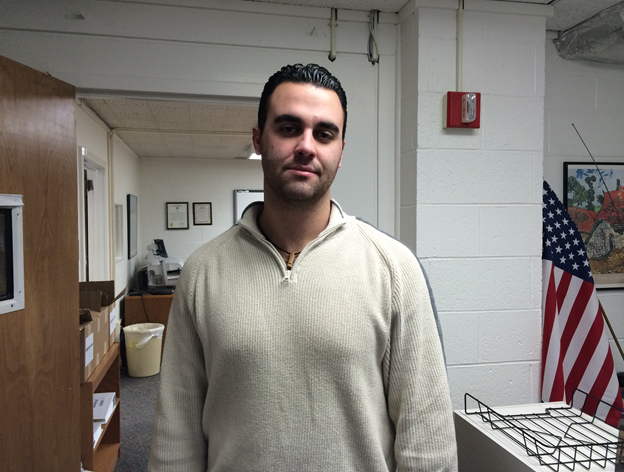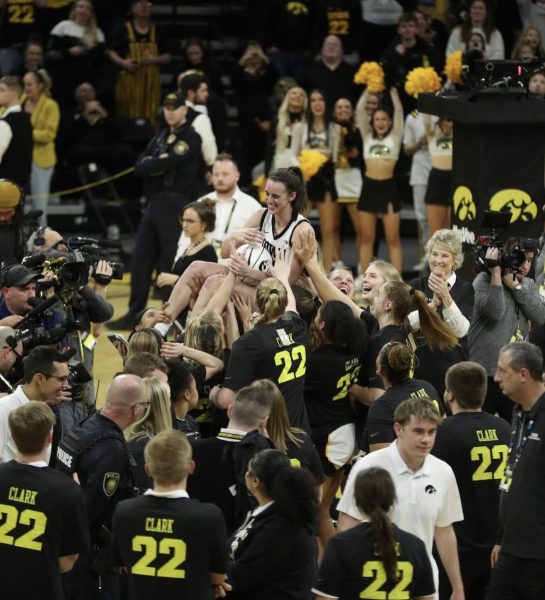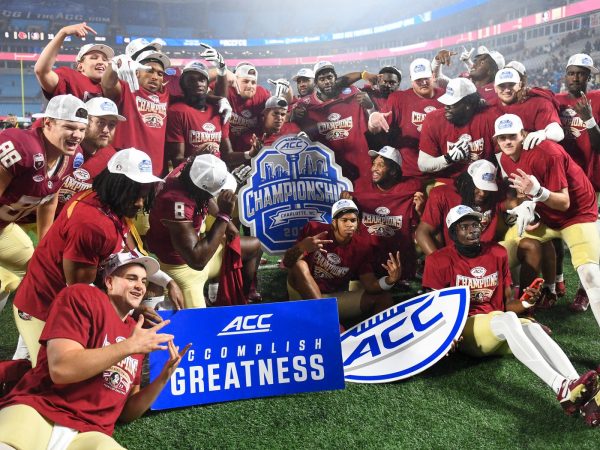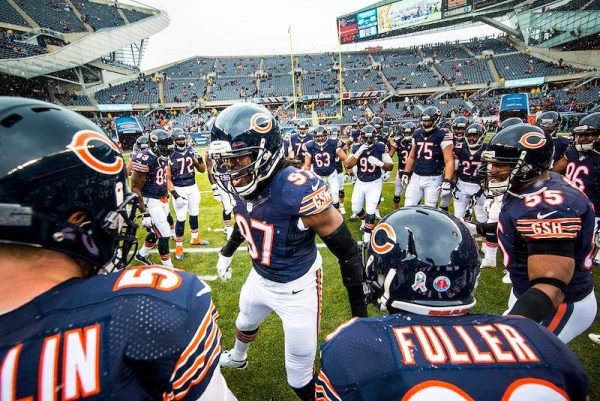Football rules lead to less contact
May 26, 2015
Altogether, football pads weigh around 20 pounds.
Combine the weight of the equipment with the force generated by two full size bodies, slamming together at speeds of six times the force of gravity, and there’s enough momentum to generate 1,000 pounds of force, according to Sports Science.
A big hit could really do a number on a player.
These are the average numbers for a 250 pound man, which most lineman at a high school level weigh.
All of that force, going to someone’s head or neck, could cause big problems for the person’s brain.
These are surprising numbers, but they’re just one reason that New Jersey has recently implemented a new rule for high school football.
21 percent of all traumatic brain injuries in teens and adolescents is due to sports, one of those sports being football.
One in every three football players will experience brain trauma in his career.
Brain injuries were down in 2014 compared to the two years before because of the targeting rule being put into place for the 2014 season.
The targeting rule states players are not allowed to hit a defenseless player in the head or neck area with their shoulder.
“I don’t mind it. You’re trying to save kids from getting injured or hurt,” Defensive Line coach Mike Line says. “Anything that can keep kids from getting injured or hurt, I’m all for,”
These new rules will keep kids from getting hurt as much as years before, however shortening the hitting time in practice could affect a player’s ability to compete at a high level of athletics.
It is possible that lessening the amount of hitting in a week of practice could make players play more conservatively, which makes a difference on the field in that the player could shy away from contact.
This can cause breakdowns on defense and turnovers on offense.
If the offensive players aren’t running plays full speed the skill players could get used to the slower or easier defense. In turn, when the players are in a game, they could take big hits which would be less common during practice, along with the players fumbling or drop passes.
On the defensive side the players would not hit the offensive players as often, which would lead to a weak defense. they would not hit hard they would not try to cause incompletions by hitting wide receivers hard after a catch. They would be playing on their heels, not being aggressive not attacking the ball mostly just waiting for the play to develop and stop the opposing player from scoring rather than trying to cause turnovers. This will be harder for players who are just starting tackle football rather than those who have played before at a high level and competed against tough opponents. For most high school football players they know how to play in a game so this change might not affect them as much as the kids who are approaching this level of play. This rule might not have the biggest effect on players now, but the long term effects could be devastating to the young players just starting out.

Ryan Dooner, sophomore running back
“If we follow this rule we will be a completely different team compared to last year. It is going to make us ‘softer’ in the game,” Ryan Dooner, sophomore running back, said. It is definitely true that the team will be different in one of two ways. Either the team will not be ready for the games or the team will have many fewer injuries. The coaches will prepare their team with these restrictions and they will be ready to play and all the players will be at less of a risk of getting injured. “It has to be quality time, you just can’t waste the time if you can only hit for 90 minutes. It has to be quality hitting,” Line said. By quality hitting he means that when the team does hit they get the most out of it, the team is aggressive and gives it their all.
Another problem with football players these days is that they try to play through any kind of pain even serious pain, like concussions. So it will be less likely for a kid to get a concussion in practice then try to play through it in a game.
There have been many cases of Second-impact Syndrome, which is when a player of any sport has a concussion and continues to practice or play before letting it heal and they get hit really hard again and their brain swells up to a size that is bigger than the skull. The brain gets crushed and bleeds leaving the person dead.
This rule can help keep kids from getting hurt in practice so they can avoid going into a game with a concussion and getting hit and possibly dying. “Safety is always the number one factor and these changes are in the best interest of the players. So yes there are some major benefits but as always there are some downfalls as well,” Coach Kurz, head coach, said. If there are fewer injuries in practice, when the players get back to the game there will be a lessened risk of re-injuring the same spot or making it worse. If a kid has a problem with his or her knee coming out of practice and they play it off and play in a game there is a huge risk of that kid tearing a ligament or dislocating the knee. This will obviously not happen if the kid has a bruised knee, but if it is something serious they will be at risk.
Some coaches have already made practice so that there is less hitting as it is. “I honestly do not this we will have to change too much because we already started implementing less hitting over the past few years,” Kurz said. This is a great thing, the kids will still be practicing like they already were essentially and that will make the way they prepare for a game similar to last year.

Coach Crispino, Special Teams coach
“It’s always a challenge simulating game speed and is nearly impossible. The idea behind the rule is to prevent injuries so it’s important to keep our players healthy for the games,” Coach Crispino, special teams coach, said.
Practice is where players work out their technical issues and hit to have a little fun. It is also a time for the coaches to evaluate the players and see who they want to give a chance to play. So, one on ones and other hitting based drills are essential to fully evaluate the players. This hitting time is also a time for players who come back from the year before and challenge those who are ahead of them on the depth chart. This rule won’t necessarily make all of these essentials change it will just need to be spread out more throughout the week. There will be more work on technical aspects of the game and running plays.
There is no way to appease both sides of this argument. You can’t be completely safe all the time, and be very aggressive coming out of a practice and going into a game. There is also no apparent way to regulate this rule and it would take too many resources to appoint an official to every school. Even if they were able to, there aren’t enough officials that know the rule in and out. This would bring up the biggest question; who would be making sure that no team hits for 10 hours in a week? Some schools could get away with hitting more than the allotted time. This would have no consequences except for more injuries for that team. It wouldn’t be beneficial to not add changes to the rules because if there were no changes and head slaps and clotheslines were still allowed kids would get really hurt and plus the fact that the helmets don’t protect the players’ head as well as it should.
“The only benefit to the team is that kids will be a little healthier,” Matt Lange, junior lineman, said. But with these changes in safety also comes changes in the nature of the game.
At football’s beginning there were bad injuries and even deaths on the field because of the minimal amount of pads and protection they wore (leather helmets) and the way they played the game they all lined up in a V-formation and because of this some players were trampled to death so Theodore Roosevelt, who liked football, made rules for the game so that people wouldn’t die. He ended the V-formation tactic and made it so that the players can survive a game.
Nowadays it is a lot different, especially with the skill players. Back in the day these players got hit without mercy, but now you can’t even breathe on them or else it is a penalty. Also the defensive players let up big gains because they can’t even come in contact with a receiver until that receiver has touched the ball, leaving the field wide open for the receiver to run to the end zone and score or at least get close.
In this year’s playoffs in the NFL the Dallas Cowboys got away with a terrible call for Pass Interference. This call was originally against the Cowboys for Pass Interference which is classified as; a defensive who interferes with a receiver’s ability to make a fair attempt at catching a forward pass. If a player were to bump into a receiver before he was able to catch the ball it is a penalty to the spot of the foul which could amount to a lot of yards. Another rule that is also very different is a players’ ability to hit the quarterback. There was a rule put into place a while ago preventing quarterbacks from getting hurt because of a late hit. The penalty was called “roughing the passer.”
Once the quarterback releases the ball the referees give the defenders two steps to hit the quarterback, but if the defender is able to stop their momentum, they should not go through with the hit. This is a good rule because the quarterback is a crucial member of the team and isn’t normally a big guy so if the first string quarterback gets hurt and the second string quarterback who has less experience comes into the game due to a late hit it could change the outcome of the game. Quarterbacks in this area are usually around 5’10” and 180 pounds. Some quarterbacks can get up to 6’3” and 230 pounds which is very big, but is severely lessened the higher you go in players’ ability and skill level.
There was also another rule change a long time ago having to do with an illegal man downfield. This is penalty that is called when a lineman, who doesn’t have an eligible number, goes down field. This was put in place to prevent offensive players down field from making blocks on defenders making it nearly impossible to make a play.
At the collegiate level there were injuries ranging from scary concussions like Jahvid Best in a game where he jumped over the goal line and was hit by a defender at his feet, Best landed on his head and was knocked out and his arms contracted. This is due to the brain hitting against the skull and the body responding by shutting down the person’s motor skills for a split second. Players of football always try to hit the other teams players as hard as they can so problems with the way players tackle can occur and it occurs often. They put their heads down to do as much damage to the opponent as possible and end up risking the chance that they get injured. A player puts their head down and makes contact with another player’s head with the top of the hitter’s head. This leads to many spinal injuries because of the sudden force directly on the neck area.
There is a new certification football coaches have to undergo called heads up training. This training makes the coach train the players to hit with their head up. Players have to keep their head up when making a tackle. This training was made so that anyone making a tackle can avoid neck injuries.
These injuries were apparent when multiple players were paralyzed by making a hit like Eric LeGrand. Eric Legrand was a big guy and was very strong, but in a game on Oct. 16, 2010 he tackled with his head down and broke one of his vertebrae and was paralyzed from the neck down. The new training is important to keep players from ruining their lives forever. In LeGrand’s case he is able to walk again after strenuous physical therapy to be able to accomplish this.
Other rules such as the illegal hands to the face rule that helps any player from getting punched or hit in the face with another players’ hands. This will prevent altercations on the field and concussions.
The reason these changes happened because of the NFL. All of these rules came about because the NFL has been going through major changes in the past few years. There have been lawsuits against the NFL for former players being allowed to go back into a game after getting a concussion. That had been going on for years and now that these former players are severely messed up because of the lack of regulations in the game due to these problems in the past couple of years the whole game has changed.
In the NFL head slapping or what is now illegal hands to the face was made illegal because of Deacon Jones. Also Dick “Night Train” Lane made a name for himself by hitting ball carriers and other skill players really hard and clotheslining them. This was outlawed. Back then the amount of concussions was very high and nobody had a problem with it but as the years went on these players had serious brain ailments.
Look at Junior Seau: he seemed fine and was a great football player. As his life progressed, though, his brain basically deteriorated and this ended in his suicide.
These changes wouldn’t have been made if there wasn’t a problem, but clearly there is a problem. Too many players are having issues in their lives day to day after competing in this sport with basically no rules. Now the game is much safer and you don’t see as many big time brain injuries as there have been in the past. Now that this new rule is being added in high school there should be fewer concussions than before.
The practice rule change where teams can only hit for 90 minutes a week was put in place to save lives and prevent serious injuries like these.






